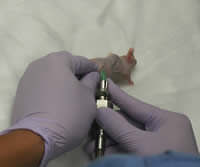Gels are solids that are composed of a dilute network of material within a liquid domain. Examples range from familiar items like Jell-O to biomaterials, like the the lens of an eye, to hydrogels, like those found in absorbant diapers. The mechanical behavior of these materials is key to their utilization in both nature and new technology and is a function of the microstructural make-up of the material. Currently, our group characterizes this microstructure/property relationship from both design and property measurement perspectives. To this end, we have developed a novel characterization technique we call Cavitation Rheology that is capable of locally quantifing the mechanical properties of soft materials, such as hydrogels.
Cavitation Rheology
Cavitation Rheology takes advantage of the unique elastic instability associated 
